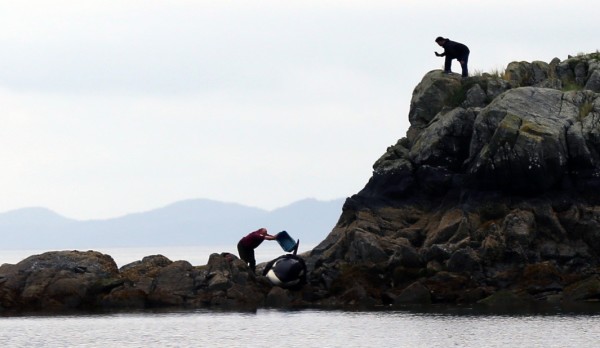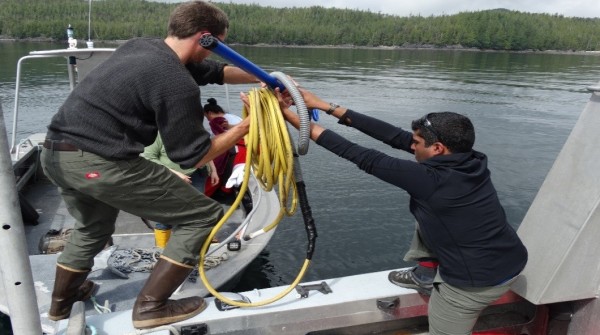Orca rescue 101
At about 8:30 a.m. on Wednesday, I was on boat with Hermann Meuter and Janie Wray from Cetacea Lab when a call came over the radio urgently asking for help with a stranded orca.
We were heading from Hartley Bay to Gil Island in northern B.C.’s Great Bear region to look at a hydrophone network that Cetacea Lab, the Gitga’at First Nations and WWF are collaborating on – but the day took a very different turn and I found myself witnessing the very emotional rescue of a nearly 3-ton female orca.
We arrived in upper Squally Channel south of Hartley Bay 45 minutes after researcher Eric Keen, from Scripps Institute of Oceanography, sent out the call. Eric was in the area researching fin whales when he spotted the orca struggling to escape a rocky burrow as the tide dropped. He’d already been joined by group of Gitga’at Guardian Watchmen who were in the area aboard their boat, the Gitga’at Guardian.
As we motored in closer, the first thing I heard was the heart wrenching sound of an orca that was clearly in distress. Her vocalizations echoed across the small bay, an alarming deep and rounded cry that flattened into a squealing moan. I also noticed that a few members of her pod were nearby, anxiously circling the island as the whale called out.
We joined the Gitga’at Guardian and The Bangarang, Eric’s research vessel, which were anchored roughly 50 meters away from the stranded whale. She was wedged in a small outcropping of rocks, and we suspect that she likely got stuck there while hunting for harbor seals with her pod. After carefully assessing the situation and in consultation with DFO’s John Ford and Paul Cottrell who were reached over satellite phone, the team knew it had to act fast to keep her cool, covered in water, and calm. This was especially urgent as the tide continued to drop and the temperature rose.
Keeping the number of people on the island to a minimum was essential, so only Hermann and a few others jumped off the boat with blankets, buckets and eventually – thanks to Eric Keen’s ingenuity – a small manual pump that helped maintain a constant flow of water.
In the right hours that followed, I watched Hermann, Eric, Janie and a handful of the Gitga’at Watchmen keep the whale cool with a continuous flow of water and wet blankets as the tide continued to rise. When the water level was high enough for the whale to breathe on its own, Hermann and the team moved away and let nature take its course.
A tense 40 minutes followed. And then, after a short struggle and one strong flip of her tail fluke she was free!
It was an incredibly emotional experience that ended well thanks to the incredible local community effort. Janie and Hermann, the Gitga’at Guardians and Eric Keen and his team all came together in one of Canada’s most remote areas to help an incredible marine mammal return to its pod.
The area of British Colombia where Hermann and Janie operate Cetacea Lab is within the Gitga’at First Nation’s territory. It is known for its abundance of whales, but also has the potential to become a busy shipping route. This is why WWF is working with Cetacea Lab and the Gitga’at First Nation to monitor the impacts of underwater noise from ships on whales and – ultimately – better understand how developments associated with increased industrial activity in this whale hotspot might impact Pacific humpbacks, threatened orcas – and other marine species.
Humpbacks and other whales are drawn to this area for one main reason: plentiful food. During the summer season, these coastal seas are packed with nutrients that provide food for tiny organisms called plankton. Forage fish such as herring feed on plankton; humpbacks, fin whales and salmon eat those forage fish. And since all whales communicate by using sound, keeping these waters quiet is extremely important. Keeping this ocean area quiet makes it easy for humpbacks, orcas and fin whales to communicate and sing their beautiful songs.
Janie Wray and Hermann Meuter came together through their shared passion to protect and research whales on Canada’s Pacific Coast. Heading north to B.C.’s Great Bear region, they gained permission from the Gitga’at First Nations to build Cetacea Lab, a hydrophone research station on remote Gil Island. Since 2012, WWF has worked with Cetacea Lab and the Gitga’at First Nation to support their work to monitor and protect whales.



